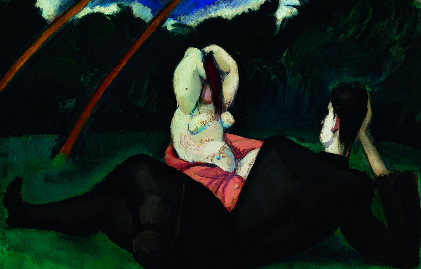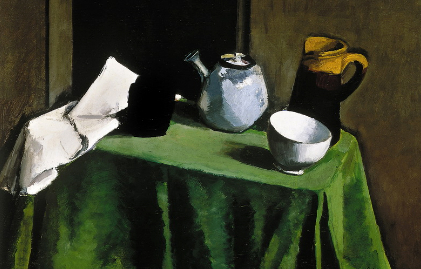The Eight at the Museum of Fine Arts
The exhibition to run at the Museum of Fine Arts from the middle of May will present works by The Eight, a group of painters closely associated with the international trends that arose in the fine arts at the beginning of the 20th century.
| Magyar Múzeumok Online |
2011-05-18 09:40 |
T he Budapest show comprising some 200 works adopted a reworked concept of the recently closed The Eight in Pécs and will showcase prominent works selected from the Pécs exhibition. Although visitors to the Museum of Fine Arts will see fewer works, some pieces that were not displayed in Pécs will now be included in the Budapest exhibition. The Museum of Fine Arts is proud to host The Eight, since its permanent exhibition of European art provides an ideal framework for the masterpieces that represent perhaps the most outstanding period of Hungarian fine art. (Photo: Róbert Berény - Idyll)
he Budapest show comprising some 200 works adopted a reworked concept of the recently closed The Eight in Pécs and will showcase prominent works selected from the Pécs exhibition. Although visitors to the Museum of Fine Arts will see fewer works, some pieces that were not displayed in Pécs will now be included in the Budapest exhibition. The Museum of Fine Arts is proud to host The Eight, since its permanent exhibition of European art provides an ideal framework for the masterpieces that represent perhaps the most outstanding period of Hungarian fine art. (Photo: Róbert Berény - Idyll)
The members of The Eight (Róbert Berény, Dezső Czigány, Béla Czóbel, Károly Kernstok, Ödön Márffy, Dezső Orbán, Bertalan Pór, Lajos Tihanyi) created their own style in the early years of the 20th century, mainly inspired by French Modernism. Their Budapest exhibition in 1909 was a turning point in the history of Hungarian art, since for the first time the public was introduced to a group of young artists whose work was closely associated with the most modern international trends. The painters of the group mostly drew their inspiration from the Fauves, primarily Matisse, and from Cézanne. Their painting style shows a transition from initially relaxed and strong tones to a kind of classicising monumentalism, while the last show of the group, which resulted in their break-up, also included works in the vein of Cubism and, mostly, Expressionism.
The three contemporaneous exhibitions of The Eight were accompanied by cultural events of the highest standard with the active participation of artists and thinkers such as the poet Endre Ady, the composers Béla Bartók and Zoltán Kodály, and the philosopher György Lukács.
The centenary exhibition of The Eight in Budapest closely ties in with the previously staged shows devoted to the group, namely The Hungarian Fauves, organised in 2006 at the Hungarian National Gallery, the highly successful travelling exhibition Fauves Hongrois in France (Céret, Le Cateau-Cambresis, Dijon) in 2008-2009, and The Eight, an exhibition hosted by the city of Pécs and highlighted as a pillar programme of the Pécs European Capital of Culture project.
The Budapest exhibition is a reworked and reorganised version of the Pécs show. While the original concept is unaltered in its main outlines, some details have been refined, concentrating on the most prominent works, and some important masterpieces, which were not displayed in Pécs, have been added. In contrast to the Pécs exhibition, which was aimed at presenting the full range of the group’s oeuvre, the Budapest version seeks to provide a comprehensive picture of their work.
 Outstanding among the works is Dezső Orbán’ reclining female nude dated 1912, borrowed from Australia, a work which was believed to be lost and will now be seen for the first time at an exhibition after more than 90 years. Visitors can also see three of Béla Czóbel’s recently discovered paintings, dated 1905, which are regarded as definitive works of his Paris period.
Outstanding among the works is Dezső Orbán’ reclining female nude dated 1912, borrowed from Australia, a work which was believed to be lost and will now be seen for the first time at an exhibition after more than 90 years. Visitors can also see three of Béla Czóbel’s recently discovered paintings, dated 1905, which are regarded as definitive works of his Paris period.
The exhibition concept of both the Pécs and Budapest exhibitions is built on an attempt to reconstruct the three contemporaneous Budapest shows of The Eight (1909, 1911, 1912), who would celebrate their 100th year anniversary in 2011. The core material is complemented by a representative selection of the works made by the members between 1904 and 1914. The Museum of Fine Arts places more emphasis on the main antecedents to the formation of The Eight; thus, the role played by the Circle of Hungarian Impressionists and Naturalists (MIÉNK) will be touched upon. An entire row of rooms will be devoted to works made by Károly Kernstok in Nyergesújfalu that provided the basis for the group’s formation, as well as to the works conceived in Paris, primarily in the vein of the Fauves. These two sections will also showcase several important works that were included in the representative exhibition titled Dialogue du fauves, which ran in Brussels at the same time as the Pécs show, and thus have only recently become available for the exhibition of The Eight. (Photo:Dezső Orbán - Still life)
 The works are arranged into three main logical units, each occupying a separate row of halls and corresponding to the three contemporaneous shows of The Eight. The individual achievements of the members will also be showcased; hence, in the spirit of the group’s 1911 show at the National Salon, the retrospective collection comprising Róbert Berény’s works will enjoy a prominent place, and, thanks to the exhibition space, which is more favourable compared to that in Pécs, more emphasis will be placed on the monumental painting that is linked with Bertalan Pór and constitutes one of the counterpoints to Berény. Following a chronological order, the section devoted to the monumental works of The Eight is divided into two parts; thus, unlike at the Pécs exhibition, the reconstruction of Kernstok Károly’s glass window designed for the Schiffer villa can be seen at the very end of the exhibition. The row of halls preceding this contains the works that formed part of the last exhibition of The Eight, in 1912. In contrast to the arrangement in Pécs, the most important works in this section are displayed as an uninterrupted unit.
The works are arranged into three main logical units, each occupying a separate row of halls and corresponding to the three contemporaneous shows of The Eight. The individual achievements of the members will also be showcased; hence, in the spirit of the group’s 1911 show at the National Salon, the retrospective collection comprising Róbert Berény’s works will enjoy a prominent place, and, thanks to the exhibition space, which is more favourable compared to that in Pécs, more emphasis will be placed on the monumental painting that is linked with Bertalan Pór and constitutes one of the counterpoints to Berény. Following a chronological order, the section devoted to the monumental works of The Eight is divided into two parts; thus, unlike at the Pécs exhibition, the reconstruction of Kernstok Károly’s glass window designed for the Schiffer villa can be seen at the very end of the exhibition. The row of halls preceding this contains the works that formed part of the last exhibition of The Eight, in 1912. In contrast to the arrangement in Pécs, the most important works in this section are displayed as an uninterrupted unit.
The recently made documentary based on scholarly research aimed at familiarising the public with the activities of the group will debut at this exhibition.
Curators: Gergely Barki, Péter Molnos, Krisztina Passuth, Zoltán Rockenbauer and József Sárkány.
Exhibition organisers: Gergely Barki, Zoltán Rockenbauer
Web: Museum of Fine Arts